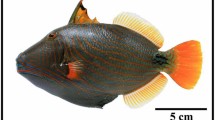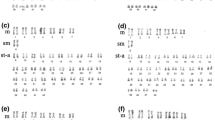Summary
Hybridization of restriction enzymedigested genomic guppy (Poecilia reticulata, Poeciliidae) DNA with the oligonucleotide probe (GACA)4 revealed a male-specific simple tandem repeat locus, which defines the Y chromosome in outbred populations. The related (GATA)4 probe identifies certain males with the red color phenotype. In contrast only in two out of eight laboratory guppy strains was the typical (GACA)4 band observed. By specific staining of the constitutive heterochromatin one pair of chromosomes could also be identified as the sex chromosomes, confirming the XX/XY mechanism of sex determination. All males exhibit Y chromosomes with a large region of telomeric heterochromatin. Hybridization in situ with nonradioactively labeled oligonucleotide probes localized the (GACA)n repeats to this heterochromatic portion. Together these results may be regarded as a recent paradigm for the differentiation of heteromorphic sex chromosomes from a pair of autosomes during the course of evolution. According to the fish model system, this may have happened in several independent consecutive steps.
Similar content being viewed by others
References
Beçak W (1983) Evolution and differentiation of sex chromosomes in lower vertebrates. In: Müller U, Franke WW (eds) Mechanism of gonadal differentiation in vertebrates. Differentiation [Suppl] 23:3–12
Blin N, Stafford DW (1976) A general method for isolation of high molecular weight DNA from eukaryotes. Nucleic Acids Res 3:2303–2308
Epplen JT (1988) On simple repeated GATA/GACA sequences in animal genomes: a critical reappraisal. J Hered 79:409–417
Haaf T, Schmid M (1984) An early stage of ZW/ZZ sex chromosome differentiation inPoecilia sphenops var.melanistica (Poeciliidae, Cyprinodontiformes). Chromosoma 89:37–41
Kallman KD (1984) A new look at sex determination in poeciliid fishes. In: Turner BJ (ed) Evolutionary genetics of fishes. Plenum Press, New York, pp 95–171
Kirpichnikov VS (1981) Genetic bases of fish selection. Springer Verlag, Berlin
Ohno S (1967) Sex chromosomes and sex linked genes. Springer Verlag, Berlin
Ohno S (1972) So much “junk” in our genome. In: Smith HH (ed) Evolution of genetic systems. Gordon and Breach, New York, pp 366–370
Ohno S (1974) Protochordata, cyclostomata and pisces. In: John B (ed) Animal cytogeneitcs, vol 4. Chordata 1. Bornträger, Berlin
Schäfer R, Zischler H, Birsner U, Becker A, Epplen JT (1988) Optimized oligonucleotide probes for DNA fingerprinting. Electrophoresis 9:369–374
Schmid M (1983) Evolution of sex chromosomes and heterogametic systems in Amphibia. In: Müller U, Franke WW (eds) Mechanisms of gonadal differentiation in vertebrates. Differentiation [Suppl] 23:13–22
Schröder JH (1983) The guppy (Poecilia reticulata Peters) as a model for evolutionary studies in genetics, behavior, and ecology. Beratungen Naturwiss-medizin Verein Innsbruck 70:249–279
Singh L, Purdom IF, Jones KW (1981) Conserved sex chromosome-associated nucleotide sequences in eukaryotes. Cold Spring Harbor Symp Quant Biol 45:805–814
Sumner AT (1972) A simple technique for demonstrating centromeric heterochromatin. Exp Cell Res 75:304–306
Winge O (1922) One-sided masculine and sex-linked inheritance inLebistes reticulatus. J Genet 12:145–162
Winge O, Ditlevsen E (1947) Color inheritance and sex-determination inLebistes. Heredity 1:65–83
Zischler H, Nanda I, Schäfer R, Schmid M, Epplen JT (1989) Digoxigenated oligonucleotide probes specific for simple repeats in DNA fingerprinting and hybridization in situ. Hum Genet 82:227–233
Author information
Authors and Affiliations
Rights and permissions
About this article
Cite this article
Nanda, I., Feichtinger, W., Schmid, M. et al. Simple repetitive sequences are associated with differentiation of the sex chromosomes in the guppy fish. J Mol Evol 30, 456–462 (1990). https://doi.org/10.1007/BF02101117
Received:
Revised:
Issue Date:
DOI: https://doi.org/10.1007/BF02101117




